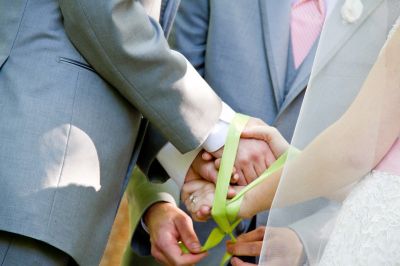
Handfasting ceremonies are growing in popularity at modern weddings but handfasting is not a modern invention, rather it has its roots in ancient folklore.
What is a Handfasting Ceremony?
Handfasting originates in the Celtic tradition and has retained an enduring permanence in Scotland. It was originally not part of the wedding ceremony but used as a means to test whether couples were compatible; the ribbons were supposed to be worn for a year and a day at the end of which two people could decide if they would like to stay together, like a sort of trial marriage, similar to a modern period of engagement or betrothal. Nowadays, the handfasting ceremony is incorporated as part of the actual wedding ceremony and is an increasingly popular symbolic ritual.
The concept of handfasting means literally tying the hands or binding fast and lies behind the saying, “tie the knot”. This ancient tradition has been seen more recently in the film ‘Braveheart’ and the Red Wedding in ‘Game of Thrones’ so has come to the attention of a more modern audience. Handfasting was legally recognised as a legitimate ceremony up until 1939 in Scotland when it lost its legal designation in the Marriage (Scotland) Act 1939. The Marriage (Scotland) Act 1977 recognised Celtic handfasting once more after a gap of forty years so now it is legally binding in Scotland as long as the Celebrant is authorised by the Registrar General.
So, how can you incorporate handfasting in your wedding ceremony and make it personal and meaningful to you?
Handfasting Ribbons
The ribbons used for handfasting (originally, it would have been cloth) can have huge symbolic meaning. The most popular method is to tie a knot for each vow leaving a tangible memory of that most special part of any wedding ceremony, a beautifully entwined cord which can be brightly coloured and will keep its vibrancy long after the wedding flowers have faded. But you can simply entwine the ribbons around the hands if you prefer.
Colours for the ribbons can be chosen that are of particular significance and meaning to the couple and some people select tartan ribbons because of the Scottish connection or if they are entitled to wear a family tartan.
Most couples choose colours which tie in with their wedding theme but you can choose a colour just for what it represents, increasing the symbolism and power of this unique ceremony. Here are some of the popular ribbon colours and their meanings:-
- Blue - tranquility, peace and devotion
- Purple – power, piety and sentiment
- Yellow – confidence and joy
- Orange – kindness, encouragement and plenty
- Red – strength and passion
- Green – health, prosperity and fertility
- White – purity and peace
Most couples choose either their favourite colours, colours to suit the wedding theme or a colour which is symbolic for another reason such as the rainbow colours, popular with the LGBT community.
The ribbons can be made of any material and again, brides will choose fabrics of significance so it may be a piece of cloth which has been handed down through the family or a section of the wedding dress material.
How to tie a handfasting cord?
Handfasting originally involved the priest or celebrant tying the couples’ hands and wrists, nowadays, the couple can decide for themselves how they want the ceremony to unfold and how long the ribbons should remain in place. The tie can be removed after the vows have been exchanged or remain in place throughout the rest of the ceremony. Some couples tie their own knot whereas others don’t use a knot at all but just wrap the ribbons around the hands. You can invite other people to help wrap the ribbons so parents, grandparents or children.
The simple act of ‘tying the knot’ is truly universal and applicable to all couples including LGBT, religious and non-religious, it is a ritual that can be relevant across all cultures and nationalities.
Most couples include it during the time when they say their vows but it is important legally that vows are exchanged accurately so if you think it may be too distracting then you can handfast after the vows and add your own form of words which the celebrant can say. Obviously, exchanging rings can be quite tricky if your hands are tied, even loosely, with ribbon so the practicalities need to be thought through carefully.
Not all religious denominations allow handfasting ceremonies – the Church of England don’t usually permit this in full although the priest will wrap his stole around the couples’ hands as part of the ritual. Civil ceremonies will permit handfasting as long as it doesn’t interfere with the contracting parts of the ceremony.
Visual, ritualistic, ancient, universal and international, there can be no more potent symbolism than two hands entwined together. A handfasting ceremony can be totally bespoke to an individual wedding and some people conduct them outside with nature as their audience or you could travel to Scotland and have a handfasting ceremony there.




